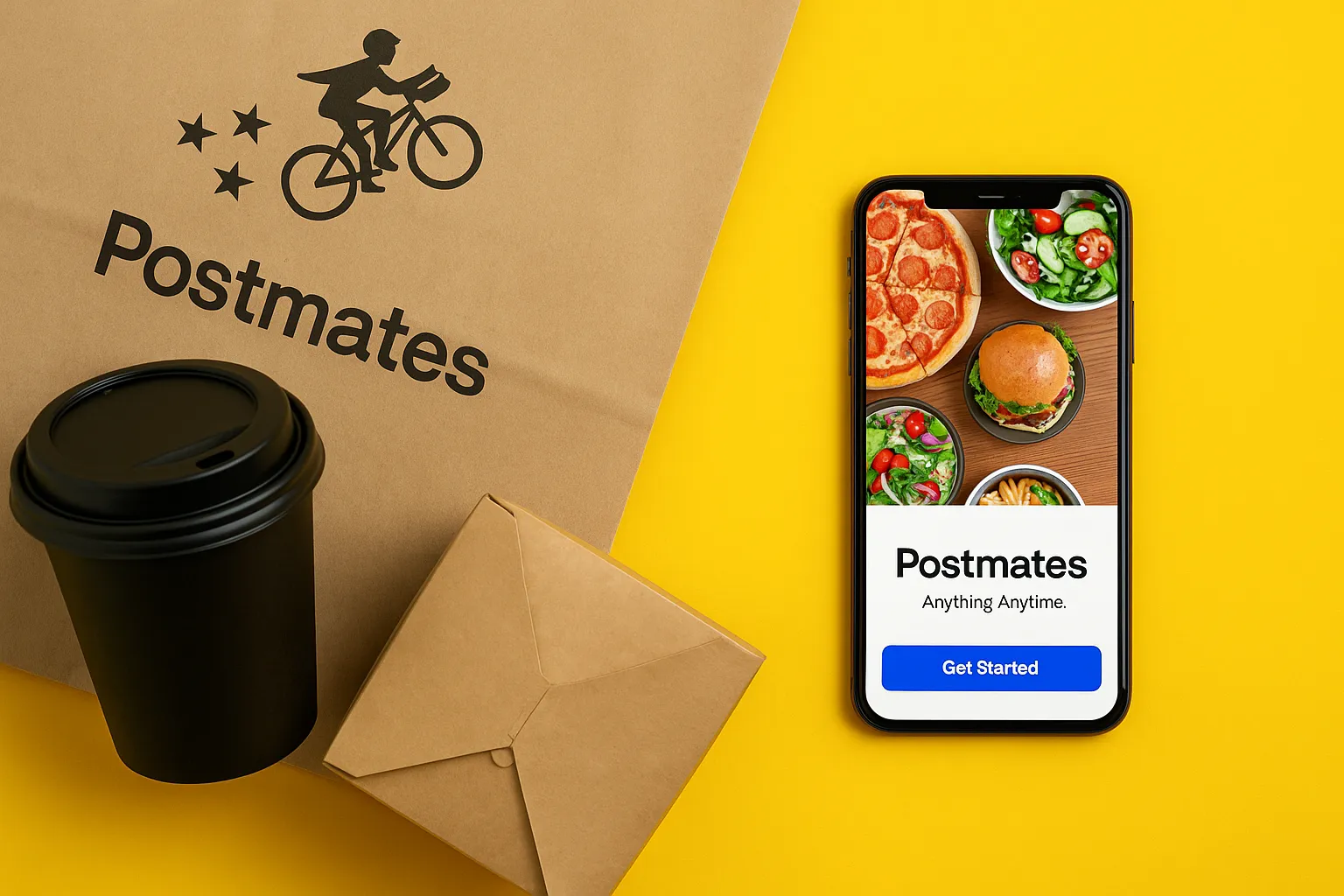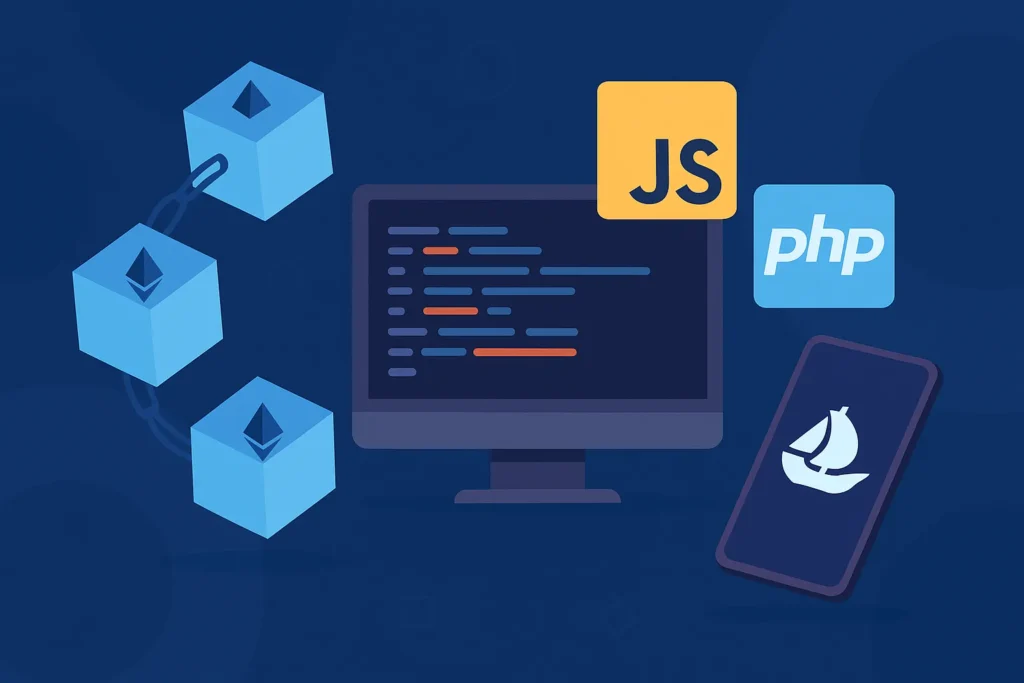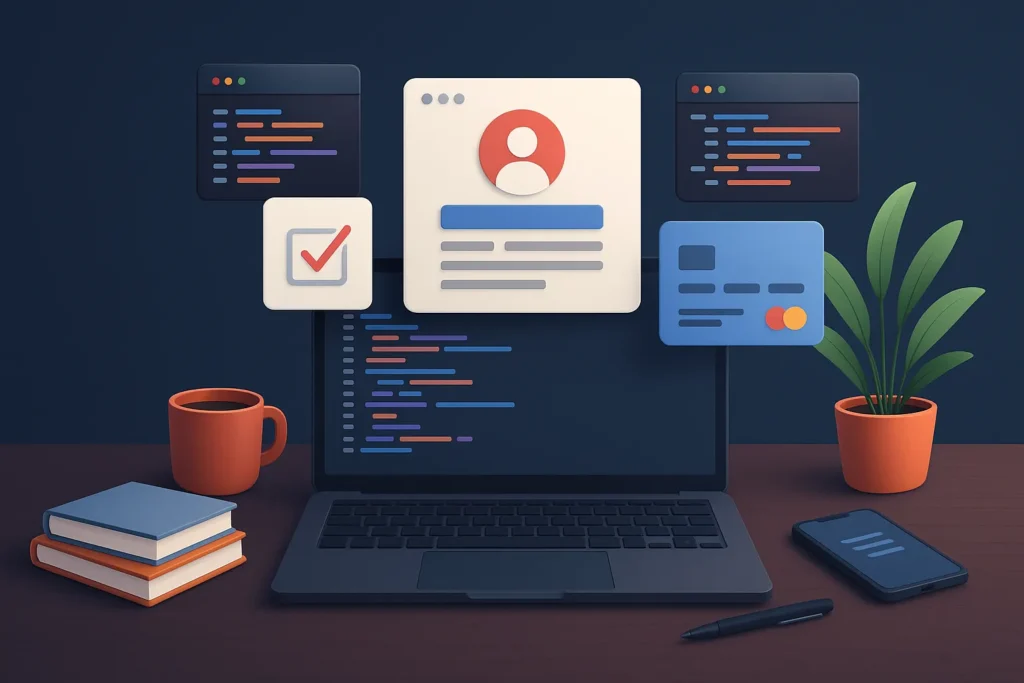Imagine you’re home sick, craving a packed market salad and a store-bought tonic — but the restaurant closed an hour ago. You open Postmates, tap a few buttons, and 30–45 minutes later a courier hands you the exact combo from a nearby shop that doesn’t usually deliver. No calls, no confusion — just fast, on-demand delivery for anything from restaurants to groceries and small-store items.
Postmates launched in 2011 in San Francisco as a local on-demand courier service that promised “anything, anytime”: meals, groceries, and odd-job deliveries. The startup grew quickly and was acquired by Uber in 2020, joining Uber’s delivery business while continuing to operate under the Postmates brand and app in many U.S. cities. Today Postmates remains an active consumer app and part of Uber’s broader delivery footprint, serving thousands of cities and contributing meaningfully to Uber Eats’ combined market presence and revenues.
What is Postmates? The Simple Explanation
Postmates is an on-demand delivery app that lets people order anything local — restaurant meals, groceries, alcohol, and store items — and have a courier pick it up and deliver it to their door, typically within an hour. It began as an independent San Francisco startup in 2011 and today operates as a consumer brand inside Uber’s delivery family while keeping its own app and merchant network.
Postmates fixes the “last mile” friction: when you need something fast but the seller doesn’t deliver (or you don’t want to leave home), Postmates connects you with a nearby courier and handles pickup, routing, and delivery so the buyer gets what they want without phone calls, cash, or running around.
Read more: Postmates Clone: Step-by-Step Guide to Building a Multi-Service Delivery App
Target users and use cases
- Busy consumers who want instant convenience (meals, groceries, alcohol).
- People who need items from shops that don’t normally deliver (convenience stores, pharmacies, local retailers).
- Small businesses that want an easy way to sell and get items delivered without building their own logistics.
Common scenarios: late-night food delivery, last-minute grocery runs, sending a package across town, or delivering a purchased gift from a local boutique.
Current market position (with 2025-relevant stats)
- Postmates continues to be a major U.S. delivery brand within Uber’s portfolio after Uber completed the acquisition in late 2020.
- The Postmates platform advertises access to hundreds of thousands of restaurants and retailers across U.S. cities via its merchant network.
- Historical usage figures show millions of active monthly users (Business of Apps reported ~9.3M monthly active users in 2021 as a baseline for Postmates’ scale prior to full integration with Uber Eats).
- In market terms, Postmates is commonly listed alongside DoorDash, Grubhub, and Uber Eats as one of the primary players in U.S. third-party delivery. It’s now functionally part of Uber’s combined delivery footprint while continuing to serve local markets under the Postmates name.
Why it became successful (short)
Postmates stood out by promising “anything, anytime” (not just restaurants), building flexible courier logistics and merchant tools early, and focusing on convenience and local retail partnerships — advantages that made it attractive both to consumers and to Uber when consolidation accelerated in the delivery market.
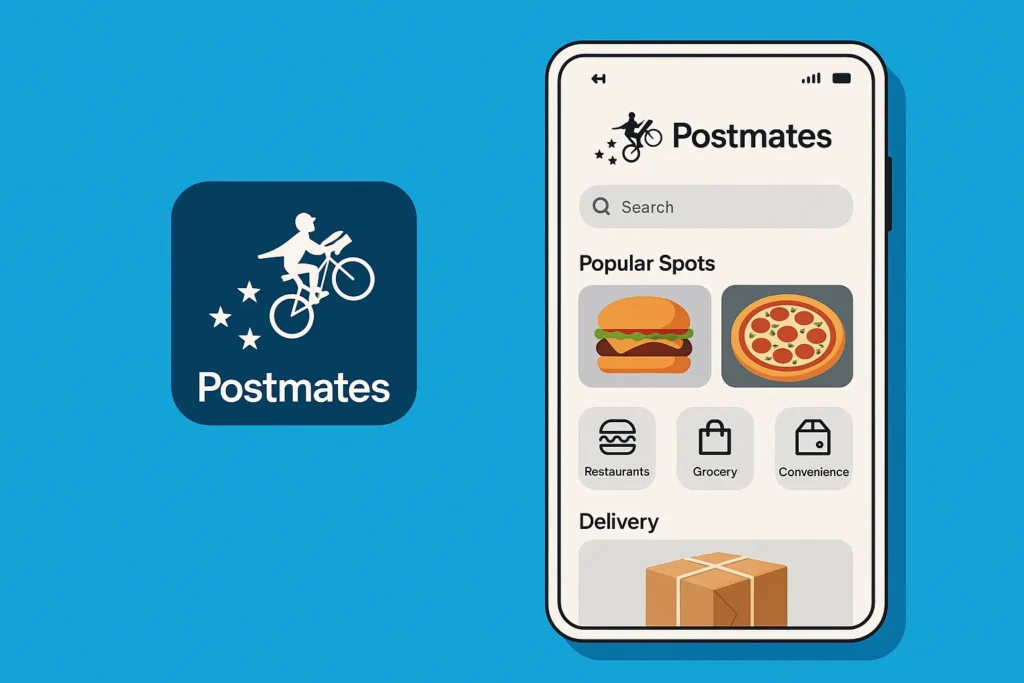
How Does Postmates Work? Step-by-Step Breakdown
Below I’ll walk you through the product from a user’s perspective, then the service-provider side, and finish with a short, simple technical overview. I’ll keep the language plain and include real 2024–2025 details where relevant.
For Users
Account creation (quick steps)
- Download the Postmates app (iOS/Android) or open postmates.com.
- Tap Sign up → enter phone, email, create password (or sign in with an Uber account if you already have one). Postmates now prompts/linking with Uber accounts in many markets so experiences, credits, and order history can be shared across the family of apps.
Main features walkthrough (what you see & do)
- Home / Search: search for restaurants, grocery stores, convenience, or “anything” nearby.
- Cart & Options: add items (including modifiers), choose delivery time (asap or scheduled), pick contactless preferences, and apply promos.
- Checkout: shows item total + delivery fee + service or convenience fee; tip option presented before/after delivery.
- Live tracking & chat: after ordering you can track the courier en route and message/call them in-app.
Typical user journey (example)
- 6:10pm: Open Postmates, search “sushi near me.”
- 6:12pm: Add salmon roll + green tea, choose “Deliver Now,” check out.
- 6:14pm: Order routed to a nearby courier, restaurant receives order on its Uber/Postmates tablet. Uber+1
- 6:30–6:45pm: Courier picks up and delivers; you watch live ETA and get a notification when the courier is nearby.
Key user functionalities explained (why they matter)
- As-applied search and “anything” promise — lets users order from non-delivery stores (convenience, pharmacies). This differentiates Postmates from restaurant-only apps.
- Scheduling & substitution — schedule deliveries and allow couriers to suggest/replace items when store stock differs (saves failed orders).
- Real-time tracking & comms — reduces uncertainty and dropped orders because users and couriers can coordinate in-app.
For Service Providers (Merchants & Couriers)
Merchant onboarding (restaurants & shops)
- Merchants sign up on the Uber Eats / Postmates partner portal, provide store info, menus, hours, and payment details. Uber consolidated merchant tools after acquiring Postmates so most merchants use a combined Uber/ Postmates tablet and merchant dashboard.
- After setup merchants receive an order tablet (or integrate via POS partners) to accept orders; they can choose delivery options (self-deliver vs. use Postmates couriers).
How couriers operate on the platform
- Postmates couriers historically used the “Postmates Fleet” app, but after the Uber acquisition delivery dispatch was consolidated with Uber’s delivery platform; new couriers generally sign up via Uber/Eats flows and accept delivery requests in the driver/delivery app used in their market. Existing couriers were migrated when possible.
- Couriers receive an order (pickup + dropoff), navigate to merchant, confirm pickup (sometimes using a merchant code or order number), and deliver to customer. They can accept/decline requests and see earnings per trip.
Earnings & commission structure (couriers + merchants)
- Couriers: pay varies widely by city and market conditions. Reported averages range roughly from mid-teens to low-twenties USD per hour depending on location, incentives, and tips (examples: Indeed, Glassdoor, and gig-pay aggregators). Instant-cash/instant-pay options are commonly available.
- Merchants (commissions): Postmates/Uber Eats uses tiered commission plans (examples historically advertised: Lite ≈15% up to Premium ≈30%). Restaurants can choose different tiers that trade off commission vs. marketing visibility. Exact rates vary by contract, region, and any local fee caps or regulations.
Technical Overview — Simple (no heavy jargon)
Basic architecture (easy summary)
Think of Postmates as five pieces working together:
- Consumer app (iOS/Android/web) — browse, order, pay.
- Merchant tablet/dashboard — receive/manage orders; integrates with POS or uses Uber’s tablet.
- Dispatch & matching engine — decides which courier gets which order based on location, ETA, and load. (Proprietary Uber dispatch after acquisition.)
- Courier app / driver platform — accepts jobs, navigation, proof of delivery. (Now largely unified with Uber delivery apps.)
- Payments & analytics backend — handles card payments, tips, merchant payouts, and dashboards.
Key technologies used (simple list)
- Mobile SDKs for iOS/Android, REST APIs (Postmates has public API docs for integrations), real-time location & mapping (Google/Mapbox), push notifications, payment processors, and routing algorithms.
Typical integrations & data flows
- Merchants can integrate via partner POS (Square, Toast) or via the merchant portal to get orders into their POS/ kitchen workflows. The platform provides APIs/webhooks for delivery creation, tracking, and status updates.
Privacy & trust basics (short)
- Customers’ payment and order info is handled by the platform’s payments stack; Postmates/Uber publish privacy and data-use notices and require merchant/courier verification and background checks for delivery partners in many regions.
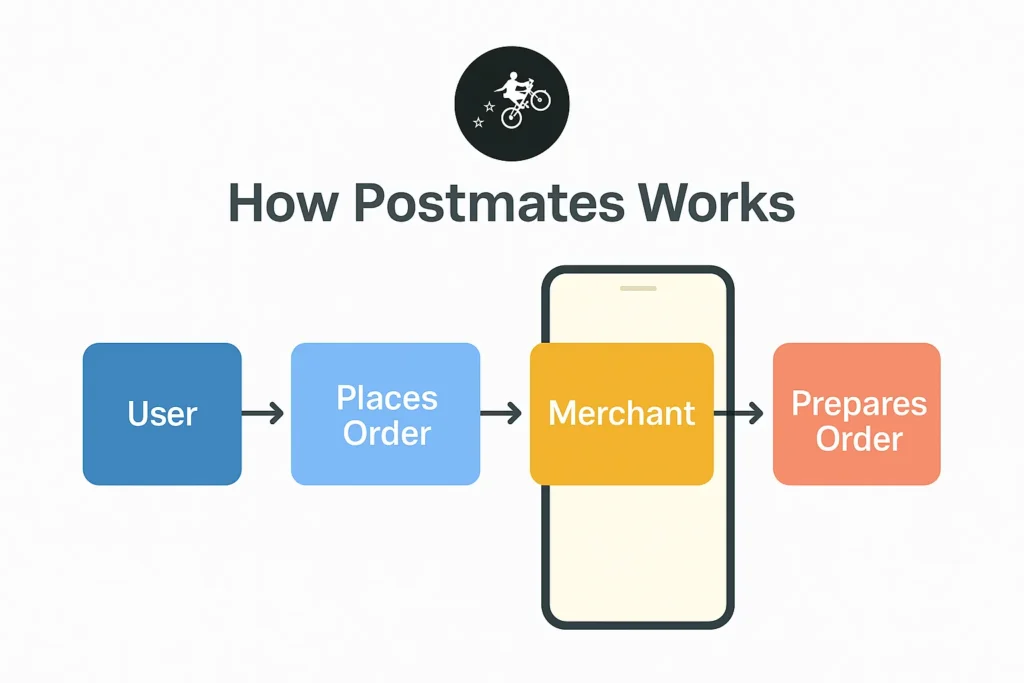
Postmates’ Business Model Explained
How Postmates Makes Money
Postmates runs on a multi-sided platform model connecting customers, merchants, and couriers. Its revenue streams come from:
- Delivery fees charged to customers (flat fee or variable by distance/market).
- Service fees (a percentage of order subtotal, often ~10–15%).
- Merchant commissions (restaurants and shops typically pay 15–30% of order value depending on their tier plan).
- Subscription (Postmates Unlimited) – a monthly membership that waives delivery fees on eligible orders (Uber has folded this into Uber One, but Postmates users can still join via the app).
- Surge & small-cart fees – extra charges when demand is high or order total is below a threshold.
- Advertising & promotions – merchants pay for boosted placement, in-app ads, or sponsored listings.
- Other revenue – API integrations, partnerships (e.g., alcohol delivery with specific retailers), and cross-platform Uber delivery ecosystem synergies.
Pricing Structure (Current, 2025)
- Delivery fee: typically $0.99–$3.99 depending on distance, merchant, and demand (often waived with Uber One/Unlimited).
- Service fee: usually around 10–15% of order subtotal.
- Small cart fee: $1.99–$2.50 if order subtotal is below a minimum (varies by city).
- Surge pricing: dynamic extra fee in peak hours (similar to Uber ride-hail surge).
- Subscription (Uber One / Postmates Unlimited): $9.99/month (free delivery + 5–10% off eligible orders).
Commission/Fee Breakdown for Merchants
- Lite Plan (~15%) → Lower commission but reduced visibility and fewer marketing benefits.
- Plus (~25%) → Balanced plan with increased exposure in the app.
- Premium (~30%) → Highest visibility with marketing support, better placement, and promotional campaigns.
- Commissions may be capped by local laws in certain U.S. cities (e.g., 15% cap introduced during COVID in NYC/SF).
Market Size & Growth Stats
- The U.S. online food delivery market is projected to surpass $55 billion by 2025 (Statista).
- Uber Eats (with Postmates) has captured ~25–30% of U.S. delivery market share, competing closely with DoorDash (~60%) and Grubhub (~10%).
- Postmates continues to differentiate in convenience/grocery categories, not just restaurants.
Profit Margins Insights
- Delivery platforms typically operate on thin margins due to high courier costs, subsidies, and customer discounts.
- Uber’s Delivery segment (which includes Postmates) reported profitability in late 2023, showing the model can scale with volume and efficiency improvements.
- Long-term profitability hinges on subscriptions, advertising revenue, and optimizing courier logistics.
Revenue Model Breakdown
| Revenue Stream | Source | Typical Range / Rate | Notes |
| Delivery Fee | Customers | $0.99 – $3.99/order | Waived with subscription |
| Service Fee | Customers | 10–15% of subtotal | Dynamic by city |
| Small Cart Fee | Customers | $1.99 – $2.50/order | If subtotal is below minimum |
| Surge Fee | Customers | Varies | Peak demand multiplier |
| Merchant Commissions | Merchants (restaurants/shops) | 15–30% per order | Depends on tier plan |
| Subscription (Unlimited/Uber One) | Customers | $9.99/month | Free delivery & discounts |
| Ads & Promotions | Merchants | Custom pricing | Boosted placement |
| Partnerships/Other | Retail & API partners | Varies | Alcohol, convenience, integrations |
Key Features That Make Postmates Successful
Top 10 Features Analysis
- Anything, Anytime Ordering
- Why it matters: Unlike food-only rivals, Postmates lets users order from restaurants, grocery stores, pharmacies, and local shops.
- Benefit: Expands use cases beyond meals → more user engagement.
- Tech: Flexible merchant onboarding + universal catalog integration.
- Real-Time Courier Tracking
- Why: Transparency reduces customer anxiety.
- Benefit: Users know exactly when and where their order is.
- Tech: GPS integration, live map updates.
- Contactless Delivery
- Why: Became crucial during the pandemic, still popular in 2025.
- Benefit: Safety + convenience.
- Tech: In-app proof of delivery (photos, notifications).
- Postmates Unlimited (Uber One Integration)
- Why: Builds loyalty by eliminating delivery fees.
- Benefit: More frequent orders and customer stickiness.
- Tech: Subscription billing + eligibility tagging.
- Scheduled Deliveries
- Why: Helps users plan meals, groceries, or gifts.
- Benefit: Flexibility.
- Tech: Backend scheduling + courier assignment algorithm.
- In-App Chat/Calls with Courier
- Why: Allows quick problem solving (wrong item, substitution).
- Benefit: Higher success rates, reduced cancellations.
- Tech: VoIP/messaging APIs integrated into courier and customer apps.
- Item Substitution Options
- Why: Stock varies in stores.
- Benefit: Prevents failed orders → keeps customers happy.
- Tech: Real-time merchant inventory + courier communication.
- Multiple Payment Methods
- Why: Wider adoption.
- Benefit: Accepts cards, wallets, gift cards, and Uber Cash.
- Tech: PCI-compliant payment gateways.
- AI-Powered Recommendations
- Why: Personalization increases basket size.
- Benefit: Upsells “people also ordered” items.
- Tech: Machine learning algorithms analyzing user history.
- Merchant Marketing & Ads
- Why: Merchants want visibility in a crowded marketplace.
- Benefit: Extra revenue for Postmates, growth for restaurants.
- Tech: Self-serve ad dashboards, ranking algorithms.
Recent 2025 Updates / Features
- Uber One + Postmates Unified Benefits: Postmates customers get Uber One perks (free delivery, discounts) in-app.
- AI Order Forecasting: Helps predict courier demand to reduce wait times.
- Green Deliveries: Expansion of eco-friendly courier options (bike, EV).
AI/ML Integrations
- Dynamic Pricing: Machine learning models balance courier supply and customer demand.
- Recommendation Engine: Suggests restaurants or items based on browsing and order history.
- Fraud Detection: AI flags suspicious transactions and unusual delivery patterns.
What Sets Postmates Apart
- Broader scope than just food → “anything” delivery.
- Strong integration with Uber ecosystem (rides + Eats + Postmates).
- Merchant flexibility (tiers, promotions, API integrations).
- Courier model optimized by Uber’s global logistics expertise.
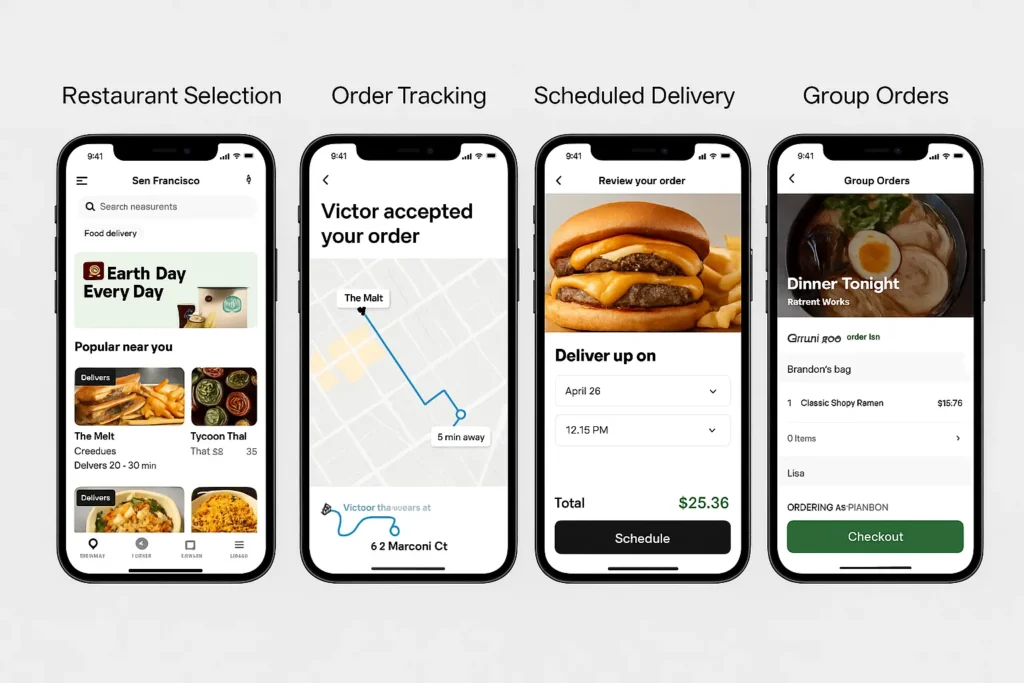
The Technology Behind Postmates
Tech Stack Overview (Simplified)
- Frontend: Native iOS (Swift) and Android (Kotlin/Java) apps, plus a responsive React-based web app for ordering.
- Backend: Built on Node.js, Python, and Go services with microservice architecture.
- Databases: PostgreSQL and MongoDB for structured + unstructured data.
- Cloud Infrastructure: Runs primarily on AWS (scalable compute, storage, CDN).
- Mapping & Routing: Google Maps API + proprietary Uber/Postmates routing algorithms.
- Payment Systems: Integrated with Stripe, Braintree, and Uber’s internal payment rails for card processing, wallet, and instant payouts.
Real-Time Features
- Courier Tracking: GPS data constantly updated in-app to show precise courier location.
- Dynamic Matching: Orders automatically routed to the nearest available courier.
- Live Notifications: Push alerts for order updates, courier arrival, and delivery status.
Data Handling & Privacy
- User Data Security: End-to-end encryption of sensitive details like payments.
- Anonymized Communication: In-app chat/call masks personal phone numbers.
- Compliance: Adheres to GDPR, CCPA, and local U.S. data laws.
- Background Checks: Couriers verified with ID and screening before onboarding.
Scalability Approach
- Microservices Architecture: Allows different functions (orders, payments, tracking) to scale independently.
- Load Balancing: Ensures smooth performance during peak demand (e.g., dinner rush).
- Auto-Scaling on AWS: Expands resources dynamically as demand spikes.
Mobile App vs Web Platform
- Mobile app: Full functionality, real-time courier tracking, payments, chat, and promotions.
- Web app: Lightweight but supports browsing, ordering, and basic tracking (optimized for desktop/tablet users).
API Integrations
- Merchant APIs: Restaurants and retailers integrate directly with Postmates for menu syncing, order acceptance, and inventory management.
- Courier APIs: Delivery tracking and job updates pushed in real time.
- Partner APIs: Payments, maps, SMS notifications, and VoIP are handled through external APIs.
Why This Tech Matters for Business
- Fast & Reliable: Ensures orders are processed smoothly even under high demand.
- Merchant Growth: APIs allow even small shops to integrate without heavy tech investments.
- User Trust: Security and transparency features (tracking, communication) keep customers confident.
- Future-Proofing: AI-driven optimization + scalable infrastructure allow Postmates to evolve with Uber’s global delivery network.
Postmates’ Impact & Market Opportunity
Industry Disruption Caused
When Postmates launched, it reshaped the concept of delivery apps. Unlike early food delivery startups, it expanded delivery beyond restaurants, letting users order “anything, anytime.” This positioned Postmates as a true last-mile logistics company, disrupting not only restaurants but also grocery, alcohol, pharmacy, and retail delivery industries.
Market Statistics & Growth
- The global online food delivery market is projected to surpass $500 billion by 2030, with the U.S. leading adoption.
- Uber Eats (including Postmates) now holds 25–30% U.S. market share, second only to DoorDash.
- Postmates contributes significant value to Uber’s delivery segment, which reached $17.7 billion in revenue in 2024, up from $16.6 billion in 2023.
User Demographics & Behavior
- Age group: Heavily used by 18–35-year-olds, urban professionals, and students.
- Usage trends: Spikes during evenings, weekends, and major events (sports games, holidays).
- Preferences: Increasing demand for convenience store items and groceries, not just restaurant food.
- Subscription adoption: Growing base of Uber One (Postmates Unlimited) members who order multiple times weekly.
Geographic Presence
- Postmates operates in thousands of U.S. cities but is primarily focused on urban and suburban areas.
- While Uber Eats expanded globally, Postmates remains strongest in the U.S. domestic market, with particular strength in cities like Los Angeles, New York, Miami, and San Francisco.
Future Projections
- AI & Automation: Smarter courier assignment and AI-driven personalization expected to reduce delivery times further.
- Grocery & Retail Expansion: Non-restaurant delivery expected to become 40%+ of orders by 2026.
- Sustainability Push: More electric bike/scooter deliveries, reduced carbon footprint initiatives.
- Advertising Growth: Merchant advertising projected to be a multi-billion dollar revenue stream by 2027.
Opportunities for Entrepreneurs
The Postmates model highlights opportunities in:
- Niche delivery services (pharmacy-only, B2B packages, specialty food).
- Hyperlocal marketplaces (city-specific delivery networks).
- Clone platforms — ready-made Postmates-style apps customized for new markets.
Building Your Own Postmates-Like Platform
Why Businesses Want Postmates Clones
The success of Postmates shows that on-demand delivery is here to stay. Entrepreneurs and startups are eager to replicate its model because:
- It covers multiple verticals (food, groceries, alcohol, retail).
- It’s scalable — one city at a time, then nationwide.
- It generates multiple revenue streams (delivery fees, service fees, subscriptions, ads).
- Consumer habits in 2025 favor convenience-first shopping.
Key Considerations for Development
- Market Selection – Choose your target geography (urban, suburban, or niche vertical like groceries or pharmacies).
- Merchant Network – Partnerships with restaurants, retailers, and convenience stores.
- Logistics & Couriers – Recruiting, verifying, and retaining delivery partners.
- Technology Platform – Customer app, courier app, merchant portal, and admin dashboard.
- Compliance & Regulations – Local delivery fee caps, alcohol delivery laws, courier labor policies.
Time and Cost Factors
- Time to launch: With a clone script or white-label solution → 7–14 days.
- Custom development: From scratch → 6–12 months depending on scope.
- Estimated cost (scratch build): $50K–$300K+ depending on features, scale, and region.
- Estimated cost (clone/ready-made): $10K–$30K+ with customization.
Essential Features to Include
- User App: Search, cart, order tracking, in-app chat, payments, reviews.
- Courier App: Job requests, navigation, proof of delivery, earnings dashboard.
- Merchant Portal: Menu/catalog uploads, order management, payouts.
- Admin Dashboard: Analytics, commissions, courier/merchant management.
- Subscription & Loyalty: Unlimited-style plan for recurring revenue.
- Marketing Tools: In-app promotions, featured listings, referral programs.
Conclusion
Postmates started as a bold promise — “anything, anytime” — and over a decade later it continues to influence how people eat, shop, and live. By merging with Uber’s global delivery network, Postmates has secured its role as a leader in the on-demand economy, shaping expectations for instant access to food, groceries, and retail products.
For entrepreneurs, the lesson is clear: on-demand convenience is not just a trend, it’s a lifestyle shift. Consumers now expect flexibility, speed, and variety — and businesses that deliver those values win loyalty.
If you’ve been inspired by Postmates’ journey and want to bring a similar platform to life, now is the best time to act. With the right technology partner, proven business models, and a focus on user experience, you can tap into the growing demand for last-mile delivery solutions and carve out your place in this thriving industry.
FAQs
Q1. How does Postmates make money?
Postmates earns through delivery fees, service fees, merchant commissions (15–30%), subscription plans (Uber One), and in-app advertising.
Q2. Is Postmates available in my country?
Postmates is primarily available in the United States. International users are redirected to Uber Eats, which operates globally.
Q3. How much does Postmates charge users?
Users typically pay a delivery fee of $0.99–$3.99, plus a service fee of ~10–15% of the order subtotal. Small cart and surge fees may apply.
Q4. What’s the commission for service providers?
Restaurants and retailers pay 15–30% commission per order, depending on their tier plan and local fee cap regulations.
Q5. How does Postmates ensure safety?
Postmates uses background checks for couriers, encrypted payments, contactless delivery, and anonymized in-app calls/messages for privacy.
Q6. Can I build something similar to Postmates?
Yes. Entrepreneurs often create Postmates-like platforms using clone scripts or custom development. Companies like Miracuves provide ready-made solutions to launch in 7–14 days.
Related Articles:



